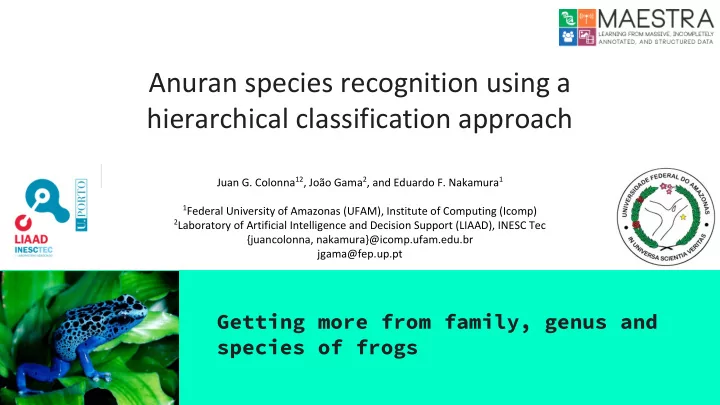

Anuran species recognition using a hierarchical classification approach Juan G. Colonna 12 , João Gama 2 , and Eduardo F. Nakamura 1 1 Federal University of Amazonas (UFAM), Institute of Computing (Icomp) 2 Laboratory of Artificial Intelligence and Decision Support (LIAAD), INESC Tec {juancolonna, nakamura}@icomp.ufam.edu.br jgama@fep.up.pt Getting more from family, genus and species of frogs
Introduction - Why frogs? - Anura is the name of an order of animals in the Amphibian class which lack a tail, this includes frogs and toads . - Frogs are very sensitive to environmental changes 2
Why monitor populations of frogs? Hypothesis: Tracking the changes in the anuran populations can help us to determine ecological problems in early stages. It involves several manual tasks! 3
Proposal Signal processing (SP) + Wireless Sensor Networks (WSN) + Machine Learning (ML) Advantages: It is Automatic, less intrusive and allows long term monitoring. 4
How to do that? 1) Pre-processing: a) Filter: band-pass filter, wavelet decomposition, etc. b) Segmentation: syllable-based approach (x k ) 2) Feature Extraction: that maps x k →c k a) Mel-frequency cepstral coefficients (MFCCs) b) Spectral centroid, Spectral bandwidth, Pitch, etc. 3) Recognition: ML technique to classify c k →ID (species ID) a) Support Vector Machine, kNN, Tree, etc. 5
Segmentation and feature extraction 6
Traditional Classification Approach Dataset with: k samples (or syllables) ● l coefficients ● one label ( s j ={j species}) ● Then, apply a “flat” classifier (kNN, SVM, etc.) Problem: the number of classes grows together with the number of species who wish to recognize increasing the complexity of the model.
Knowledge organization Carl Linnaeus has defined a particular form of biological organization called taxonomy in his work Systema Naturae (1735).
How to improve the classification using the taxonomy? - The anura Order has 31 Families (approximately) - These Families are divided into several genus - And finally, these genus are divided in almost 6000 species Hypothesis: the phylogenetic taxonomy may describe similar calls among species that belong to the same genus and family 2 . Illustrative figure. 2 B. Gingras and W. T. Fitch. A three-parameter model for classifying anurans into four genera based on advertisement calls. The Journal of the Acoustical Society of America, 133(1):547–559, 2013.
A Multi-output approach (multi-class and multi-label) Extend the dataset incorporating the new labels: Label s j = { j different species} ➢ Label g i = { i different genus} ➢ Label f m = { m different families} ➢
Hierarchical problem decomposition - Use the taxonomy relation of the labels to build a tree. One One One classifier classifier classifier per parent node per node per level
Our dataset - Indeed this is not a big-data dataset, but it is enough to prove our point.
Building our hierarchical classifier from our dataset Benefit: One Classifier per Parent Node allows us to simplify the problem Example: suppose that the first level decides in favor of the family Bufonidae . In this case there are no more splits in the tree, consequently it is not necessary to perform extra classifications to determine the species.
Hierarchical problem decomposition - Subproblem decomposition and simplification:
Experiment configuration - A kNN was chosen as base classifier in each node (k=3). - We adapted the cross-validation procedure to group syllables by individuals to test how well our method generalize. - The Average-accuracy was used in evaluations to avoid an artificially increment of the Micro-accuracy due to unbalanced number samples in each class. where Acc i is the accuracy per row i of confusion matrix, m the total number of rows, tp i are the true positives, and k i the total number of syllables per row. - Random Baseline : - Micro-accuracy = 0.50 (dummy classifier) - Average-accuracy = 0.10 (dummy classifier)
k -CV by Specimens (or individuals) Common procedure found in the Our Cross-Validation procedure by grouping related works when syllable-based syllables of the same individuals to test methodology is adopted. how well the model generalize.
Results per level Family Level (Acc = 76%) ●
Results per level Family Level (Acc = 76%) ● Genus Level (Acc = 61%) ●
Results per level Family Level (Acc = 76%) ● Genus Level (Acc = 61%) ● Species Level (Acc = 61%) ●
Summary and conclusions The hierarchical approach effectively reduces the complexity of problems ➢ maintaining an acceptable accuracy. From a classification point of view the families Bufo, Hyla and Lepto were ➢ the most similar in the feature space, and also the species Adenomera andreae and Osteocephalus oophagus. The Scinax species was the most difficult to recognize. ➢ The k CV by individuals (specimens) has an important impact in the model ➢ performance. Baseline comparison against a dummy random classifier: ➢ Micro gain = +35% and Average gain = +50% ○ Future work: Implement soft decision rules in the tree to be able to correct the error propagation from the highest levels.
Thanks - Obrigado - Gracias
Recommend
More recommend